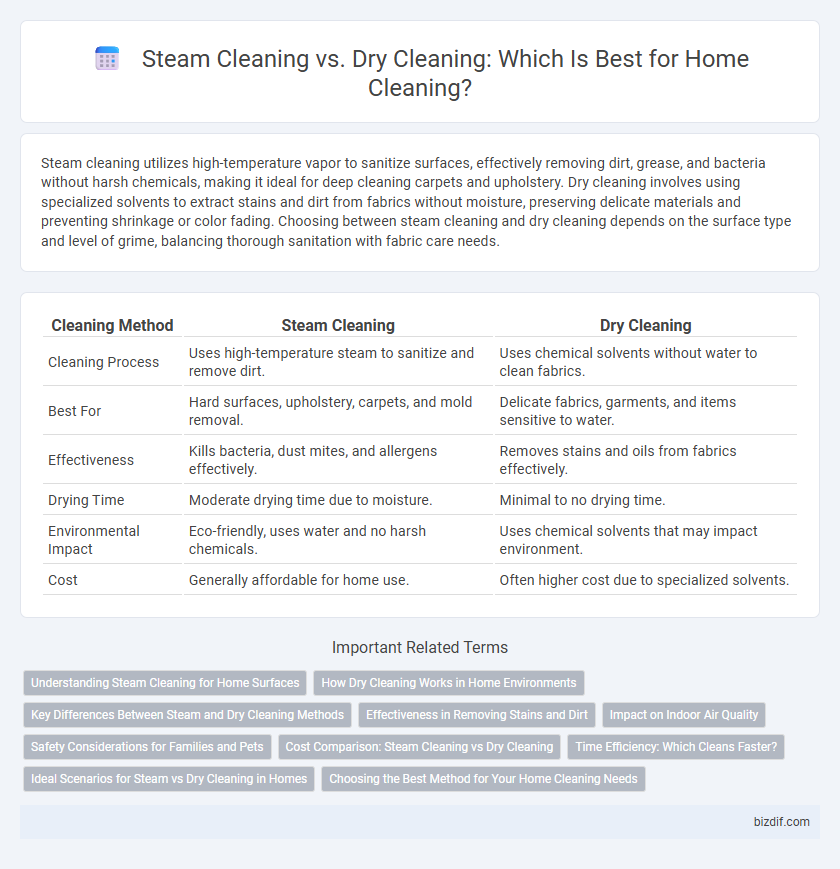Steam cleaning utilizes high-temperature vapor to sanitize surfaces, effectively removing dirt, grease, and bacteria without harsh chemicals, making it ideal for deep cleaning carpets and upholstery. Dry cleaning involves using specialized solvents to extract stains and dirt from fabrics without moisture, preserving delicate materials and preventing shrinkage or color fading. Choosing between steam cleaning and dry cleaning depends on the surface type and level of grime, balancing thorough sanitation with fabric care needs.
Table of Comparison
| Cleaning Method | Steam Cleaning | Dry Cleaning |
|---|---|---|
| Cleaning Process | Uses high-temperature steam to sanitize and remove dirt. | Uses chemical solvents without water to clean fabrics. |
| Best For | Hard surfaces, upholstery, carpets, and mold removal. | Delicate fabrics, garments, and items sensitive to water. |
| Effectiveness | Kills bacteria, dust mites, and allergens effectively. | Removes stains and oils from fabrics effectively. |
| Drying Time | Moderate drying time due to moisture. | Minimal to no drying time. |
| Environmental Impact | Eco-friendly, uses water and no harsh chemicals. | Uses chemical solvents that may impact environment. |
| Cost | Generally affordable for home use. | Often higher cost due to specialized solvents. |
Understanding Steam Cleaning for Home Surfaces
Steam cleaning utilizes high-temperature vapor to efficiently sanitize and remove dirt, bacteria, and allergens from home surfaces without the need for chemicals, making it an eco-friendly option. It is highly effective on hard floors, tiles, and upholstery, penetrating porous materials to eliminate deep-seated grime and dust mites. Unlike dry cleaning methods, steam cleaning offers a deeper level of sanitation and can often reduce the use of harsh cleaning agents, promoting a safer environment for families and pets.
How Dry Cleaning Works in Home Environments
Dry cleaning in home environments uses specialized machines that apply minimal moisture and gentle solvents to clean fabrics without water damage. This method effectively removes dirt, stains, and allergens by dissolving oils and grease while preserving delicate materials like upholstery and curtains. Home dry cleaning kits often combine solvent treatments with agitation and vacuuming to refresh garments and household textiles safely.
Key Differences Between Steam and Dry Cleaning Methods
Steam cleaning uses high-temperature vapor to sanitize and break down dirt on surfaces, making it effective for deep cleaning and removing allergens. Dry cleaning relies on chemical solvents to clean fabrics without water, preserving delicate materials and preventing shrinkage. The key differences lie in moisture usage, cleaning agents, and suitability for various surfaces and materials.
Effectiveness in Removing Stains and Dirt
Steam cleaning penetrates deep into fabric fibers and surfaces using high-temperature vapor, effectively dissolving and lifting stubborn stains and embedded dirt without harsh chemicals. Dry cleaning relies on specialized solvents that dissolve grease and oils, excelling on delicate fabrics but less effective on water-based stains and embedded soil. For comprehensive stain and dirt removal, steam cleaning offers superior deep-cleaning capabilities, while dry cleaning suits sensitive materials requiring gentle care.
Impact on Indoor Air Quality
Steam cleaning uses high-temperature vapor to sanitize surfaces, effectively killing bacteria and allergens without chemical residues, thereby improving indoor air quality. Dry cleaning methods often rely on chemical solvents which can release volatile organic compounds (VOCs) and other pollutants, potentially degrading air quality in enclosed spaces. Choosing steam cleaning over dry cleaning reduces exposure to harmful chemicals, promoting a healthier and fresher indoor environment.
Safety Considerations for Families and Pets
Steam cleaning uses high-temperature vapor to sanitize surfaces, effectively killing bacteria and allergens without harsh chemicals, making it safer for homes with children and pets. Dry cleaning methods often rely on chemical solvents that can pose health risks through inhalation or skin contact, requiring careful ventilation and restricted access during and after cleaning. Opting for steam cleaning reduces exposure to toxic substances, promoting a healthier indoor environment for sensitive family members and animals.
Cost Comparison: Steam Cleaning vs Dry Cleaning
Steam cleaning typically costs between $100 and $300 per session, offering an eco-friendly method that uses hot water vapor to deep clean surfaces without chemicals, which may reduce long-term maintenance expenses. Dry cleaning usually ranges from $150 to $400 per treatment and relies on chemical solvents, potentially increasing costs due to the need for specialized disposal and environmental impact fees. Choosing between steam and dry cleaning depends on budget constraints, desired cleaning intensity, and sensitivity to chemical use in home environments.
Time Efficiency: Which Cleans Faster?
Steam cleaning typically completes deep sanitation tasks faster by using high-temperature vapor to dissolve dirt and kill germs, reducing overall cleaning time. Dry cleaning methods often require longer preparation and finishing phases, such as vacuuming or polishing, making them less time-efficient for thorough home cleaning. For rapid yet effective cleaning, steam technology offers a notable advantage in minimizing total service duration.
Ideal Scenarios for Steam vs Dry Cleaning in Homes
Steam cleaning is ideal for deep sanitization in homes with allergies or pets, effectively removing bacteria, dust mites, and stubborn stains from upholstery, carpets, and hard floors without harsh chemicals. Dry cleaning suits delicate fabrics, antique furniture, or electronics where moisture can cause damage, providing gentle yet effective cleaning through absorbent powders or chemical solvents. Choosing between steam and dry cleaning depends on surface type, moisture sensitivity, and the level of contamination to ensure safe and thorough home cleaning.
Choosing the Best Method for Your Home Cleaning Needs
Steam cleaning utilizes high-temperature vapor to remove dirt, bacteria, and allergens from various surfaces, making it ideal for deep sanitization, especially on carpets and upholstery. Dry cleaning employs chemical solvents to lift stains and dirt without moisture, preserving delicate fabrics and preventing shrinkage, which is beneficial for sensitive materials and quick drying. Assessing your home's surface types, cleaning frequency, and sensitivity to moisture helps determine whether steam or dry cleaning offers the best balance of effectiveness and care.
Steam Cleaning vs Dry Cleaning Infographic

 bizdif.com
bizdif.com